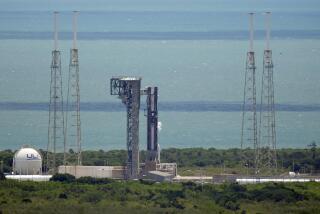Longstanding Problem Caused Engine Shutdown Last Month : New Heat Sensors Will Make Debut on Shuttle Today
- Share via
The company that builds the space shuttle’s main engines knew almost two years ago that it had a problem with sensors that protect them from overheating--the same problem that caused one engine to unnecessarily shut down during the shuttle’s July 29 liftoff.
Rockwell International’s Rocketdyne Division, which builds the shuttle engines in Canoga Park, has produced a new sensor since finding the problem. The shuttle scheduled for launching today is equipped with the devices, and NASA officials say they trust the new model even though they had planned more testing.
But the time it took to develop an improved sensor illustrates the unrelenting work of detecting and solving problems in the immensely complex shuttle. It is a task that demonstrates how space engineers can turn failure into success but also stands as an example of why the shuttle cannot easily be turned into a mature, reliable vehicle.
“I think that we fixed this sensor in a sound engineering manner and as quickly as we could,” said Ray Tjulander, who heads a 15-man NASA office at Rocketdyne. “Finding the problem was very difficult, and then you had a major redesigning job to find out how to fix it.”
Potential Disaster
How, two years after its faults were found, could a tiny instrument rock the launching of the 4.5-million-pound shuttle, shutting down one engine and forcing NASA to override sensor readings on a second engine to prevent another, potentially disastrous, engine failure?
The shuttle’s temperature sensors are like the red lights that warn that a car is overheating. But, instead of just issuing a warning, the sensors shut down a shuttle engine before it starts to self-destruct. Each of the three shuttle engines has four sensors; an engine will shut down only if two of its sensors signal heat warnings.
During test firings in 1983, the sensors reported temperatures of about 3,000 degrees Fahrenheit, 1,700 degrees over the 1,300-degree maximum temperature at which an engine can run safely. In addition, three sensors had malfunctioned during shuttle launchings, although never two at once until last month.
Bill McFarlen, a Rocketdyne engineer, was told to investigate the problems in November, 1983. Rocketdyne put McFarlen, a metallurgist, in charge of the inquiry because wild readings from the sensors suggested that a minute platinum wire, the instrument’s main nerve, was the culprit.
Wire Broken in Two
First, McFarlen’s team dissected a faulty sensor. The barely visible wire was broken in two.
Neither Rocketdyne nor NASA was surprised that the wire was the problem: It had to be thin enough to sense heat changes fast, yet thick enough to withstand the intense heat of the engine. Efforts to strengthen the device had previously resulted in a fatter wire, but its response time was too slow. Early in the program, engineers had tried a thinner wire, and many of the instruments had survived heat tests. But, by 1983, a series of breaks indicated that there was a definite problem.
Was platinum the wrong type of metal? Was there a problem with how the metals were being handled during the manufacturing process?
“It’s like being a detective at the scene of a crime,” said John A. Halchak, another Rocketdyne metallurgist. “You look first with the naked eye, then with a hand-held magnifying glass, a la Sherlock Holmes.”
The best tool for the detectives in this case was an electron microscope. It showed that the wire had a clean break, indicating that the platinum had become brittle and snapped. That, in turn, resulted in a theory that the wire had vibrated apart, metallurgist Joel M. Rosen said.
Theory Discounted
To test the theory, engineers battered samples of wire apart with sound waves, duplicating the speed of vibrations within the shuttle engine. They compared the lab samples with the actual breaks: no match. The vibration theory was blown.
The key turned out to be heat, but not the heat inside the shuttle engine. Testing the wire at a variety of temperatures, Rosen found that it weakened at 1,970 degrees Fahrenheit. And that, he learned, was the temperature at which certain alloys had been melted to join together parts of the sensor body during a manufacturing process. In the process, called brazing, alloys are heated to flow between two metal pieces. As the alloy cools and hardens, the pieces bond.
One of the problems in building the sensor, as well as many other parts of the engine, is that joints must be brazed at temperatures hotter than the engine ever gets in flight. Were this not so, the heat of the engine would remelt the joints and the engine would fall apart.
To spare the wire from the weakening effects of the high brazing temperature, Rocketdyne decided to bond its sensor pieces at 1,800 degrees, which is still 500 degrees above the top limits of safe engine operation.
Rocketdyne developed this change and several others through the spring of 1984. Much of the time since has been consumed by testing, engineers there say. Today is the first time that sensors assembled at the new temperature are being used on the shuttle.
Couldn’t it all have happened faster?
“I don’t think so,” NASA’s Tjulander said. “One of the problems of the aerospace industry is that, from the time you recognize there is a problem to the time you get a fix, takes a long time. And testing is a big part of it. If you don’t have the right fix, the stakes can be very high.”
More to Read
Sign up for Essential California
The most important California stories and recommendations in your inbox every morning.
You may occasionally receive promotional content from the Los Angeles Times.












